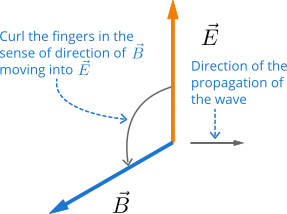The electromagnetic waves carry energy, and here we talk about the energy carried by the electromagnetic waves. Electromagnetic wave is the combination of electric and magnetic fields, and there is the energy associated with both electric and magnetic fields.
We know the expression for the energy density for the electric field and the energy density for the magnetic field. The total energy density due to both fields is
\[u = \frac{1}{2} \epsilon_0 E^2 + \frac{1}{2}\frac{B^2}{\mu_0} \tag{1} \label{1}\]
You know that \(E = cB\) and this implies \(B = \sqrt{\mu_0\epsilon_0}\,E\). If you put this value in the energy density due to magnetic field \(B^2/2\mu_0\), the result is \(\epsilon_0E^2/2\) which is the energy density due to the electric field. Therefore, the energy density due to both fields are equal to each other. The total energy density is twice the energy density due to the electric or magnetic field. So,
\[u = \epsilon_0E^2 \tag{2}\label{2}\]
Consider a plane electromagnetic wave travelling in +x-direction. Also consider a plane perpendicular to the direction of propagation of the wave. In a small time interval \(dt\), the wave travels a distance of \(cdt\) where \(c\) is the speed of the wave. If the area of the plane is \(A\), and for that area the volume occupied by the wave in that time interval is \(dV = Acdt\).
Now the total energy carried by the wave for the small volume is the total energy density multiplied by the volume, therefore,
\[dU = \epsilon_0E^2(Acdt)\]
The above expression determines the energy flow (since the wave flows) through an area \(A\) for a time interval \(dt\). Now we define the energy flow or also sometimes called energy flux as the energy flow per unit time per unit area (power per unit area) denoted by \(S\) , that is
\[S = uc = \epsilon_0cE^2 \tag{3} \label{3}\]
You can further simply the above equation using the expressions \(E = cB\) and \(c = 1/\sqrt{\epsilon_0\mu_0}\) and obtain
\[S = \frac{EB}{\mu_0} \tag{4} \label{4}\]
The energy flow is associated with a particular direction which is the direction of the propagation of the wave and we define the energy flow per unit time per unit area as a vector called Poyinting vector. And here we have assumed the direction of propagation of the wave only in +x-direction, the vector definition allows us to define the quantity in any direction in space.
\[\vec S = \frac{\vec E \times \vec B}{\mu_0} \tag{5} \label{5}\]
The SI unit of Poyinting vector is \(\text{W}/\text{m}^2\). An electromagnetic wave has both electric and magnetic fields, and they are perpendicular to each other. To determine the direction of the propagation of the wave, you can use the right hand rule, that is curl the fingers in the sense of \(\vec E\) moving into \(\vec B\) and the straight thumb gives the direction of propagation of the wave or the direction of \(\vec c\) as shown in Figure below.

The Poyinting vector also has the same direction of propagation of the wave or the velocity of the wave (apply the right hand rule). The rate of energy flow or the power through area \(dA\) is the dot product of Poyinting vector and the area, that is \(dP = \vec S \cdot d\vec A\), and if the wave has a point source, the power of the wave through a surface enclosing the source is obtained by integrating the small power to include the whole surface area.
\[P = \oint \vec S \cdot d\vec A\]
In case of the sinusoidal plane electromagnetic wave, both fields very sinusoidally and therefore it makes more sense to determine the average rate of energy flow (average power). The sinusoidally varying electric field is \(E = E_0\cos (kx - \omega\,t)\) and magnetic field is \(B = B_0\cos(kx - \omega\,t)\) where \(E_0\) and \(B_0\) are the electric and magnetic field amplitudes respectively. Note that each field is the function of both position and time.
Now we define the quantity as we defined for the sound waves called the intensity as the average rate of energy transfer per unit area or the average power per unit area. You know from Equation \eqref{4} or \eqref{5} for the sinusoidal plane electromagnetic wave that
\[ S = \frac{E_0B_0\cos^2(kx - \omega\,t)}{2}\]
You know that the average of \(\cos^2(kx - \omega\,t)\) is \(1/2\) and therefore, the average rate of energy transfer per unit area or the intensity of the radiation is
\[I = S_\text{avg} = \frac{E_0B_0}{2\mu_0} = \frac{E_0^2}{2\mu_0c} \tag{6} \label{6}\]
The direction of Poynting vector is always the same. For the wave travelling in positive x-direction, \(\vec S\) is always positive, that is when \(\vec E\) is positive (in +y-direction), \(\vec E\) is positive (in +z-direction) and when \(\vec E\) is negative (in -y-direction), \(\vec B\) is also negative (in -z-direction) and both fields are always in phase, and the cross product \(\vec E \times \vec B\) is always positive. And for the wave travelling in negative x-direction, when \(\vec E\) is positive, \(\vec B\) is negative and vice versa.
When an electromagnetic wave strikes a radio antenna, as shown in Figure 3, the electric field creates an oscillating voltage and hence current in the antenna. Once that frequency of oscillation matches that of the resonance frequency of the circuit, the radio is said to be tuned in the matching frequency. How does this happen is the electromagnetic wave is sinusoidal and oscillates. It's clear that an electric field exerts force on a charge, that is it exerts force on the free electrons of the antenna, and since the field oscillates, the force oscillates and therefore causes oscillating current or voltage.





